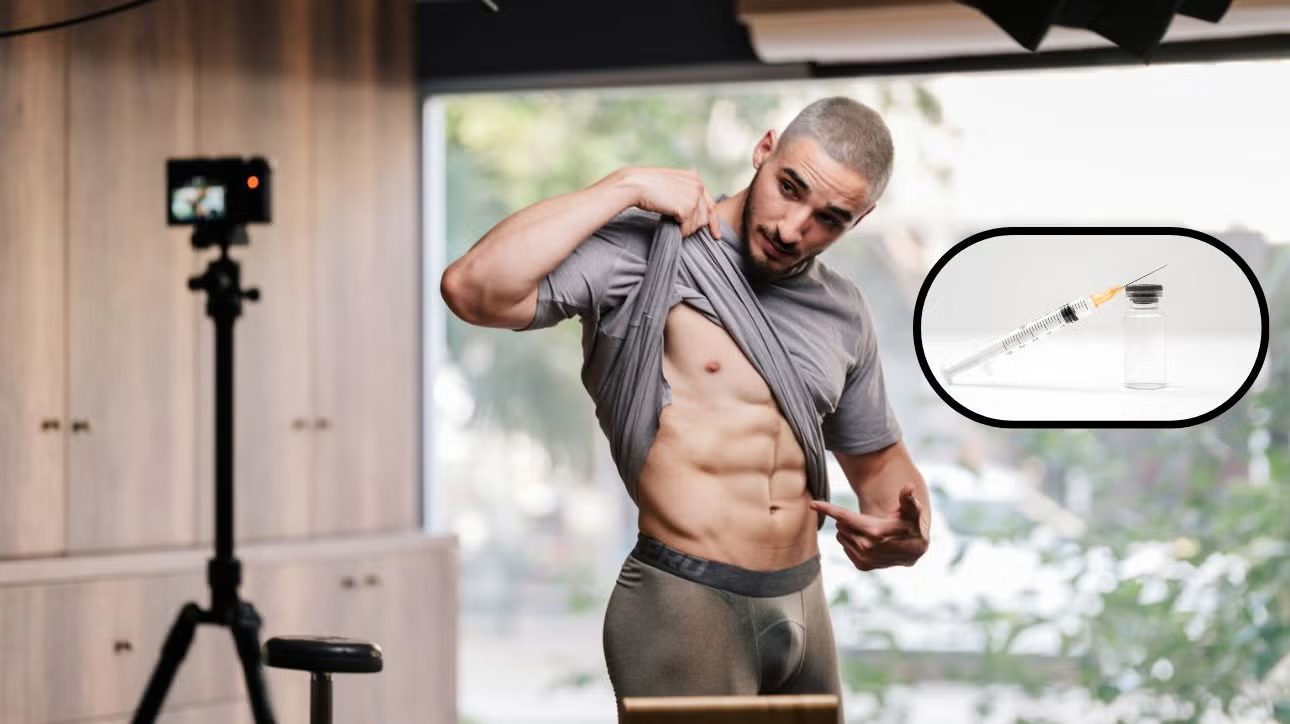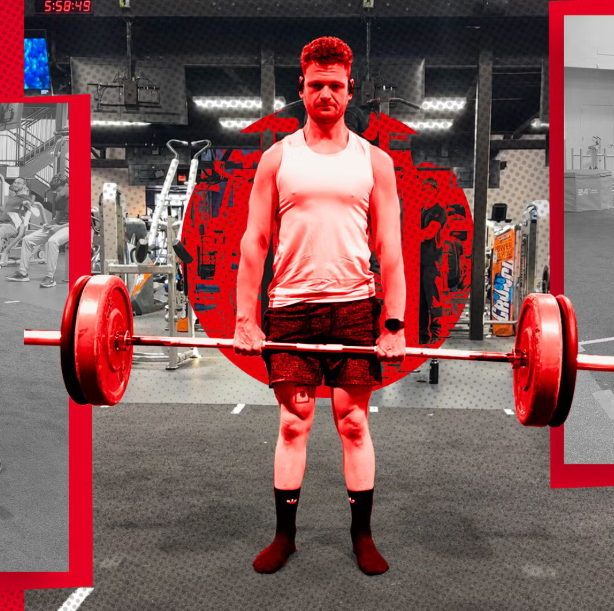THE PURSUIT OF a better physique has long driven fitness culture, but a darker shift is now unfolding on social media. Platforms like TikTok and Telegram are fuelling a surge in steroid use among young men – on TikTok through short, candid clips of their drug cycles; on Telegram through encrypted channels enabling illicit sales and advice. While events like the ‘Enhanced Games‘ openly embrace performance-enhancing drugs, this influencer-led wave risks normalising steroid abuse at scale.
Where steroid use was once whispered about in gym changing rooms, it’s now broadcast for likes and clout. Algorithms reward extreme bodies and risky routines, turning taboo into content, while closed group chats spread unregulated tips and ever more dangerous stacks. Packaged as ‘edutainment’, much of the content slips into subtle promotion and sales tactics, pulling younger users into a loop of validation, pressure, and escalation. As doses rise and transparency becomes spectacle, the fallout – body dysmorphia, infertility, shrunken testicles, heart problems – is increasingly hard to ignore.
Customer A never thought he’d be facing a heart attack at 21, but the message that just pinged on my phone suggests otherwise. It’s a PDF file containing the bloodwork results of a 21-year-old steroid user, given the pseudonym Customer A. It makes for grim reading.
The 17-page document outlines key health markers. His cortisol, oestradiol, and dangerously low prolactin levels show severe health risks, including erectile dysfunction, insulin sensitivity, increased cardiovascular risk, decreased libido, and gynecomastia – breast enlargement.
‘Bluntly, he is due for a heart attack pretty soon’
Another message follows shortly after. ‘These are the results of a young guy,’ explains Clayton Dean, owner and director of private bloodwork testing company HEAL Labs. ‘He’s a typical type that follows TikTok gurus, buying underground lab stuff. Bluntly, he is due for a heart attack pretty soon if this continues, as his fertility and hormones are shut down. It’s atrocious.’
He continues: ‘It’s something that happens on a cycle, but when the results are not monitored or treated correctly, it’s just the start of bigger problems’. These results reflect not just Customer A’s health, but a wider issue: the exposure to, and fallout from, steroid-themed content on apps like Telegram and TikTok. On TikTok, a community has emerged in the last 18 months: #TrenTok. The hashtag fuses ‘tren’ (from trenbolone, a potent steroid) and ‘TikTok’, and is populated by young men discussing their steroid use – often in detail.
Unfiltered and unregulated
Posting under #TrenTok bypasses TikTok’s ban on searching for ‘steroids’ – which triggers a warning – and acts as a space where impressionable users can pick up advice from both experienced PED users and those glorifying them. Hashtags like #teenbodybuilding and #teenfitness make the trend especially worrying. ‘This is a huge problem, and the scale of it is growing daily,’ Clayton says. ‘The sale of underground lab substances and unregulated sources of PEDs is huge now on shielded platforms like Telegram, WhatsApp, TikTok, and even Instagram.’
‘Influencers, often with no personal experience, proper knowledge or medical background, push steroid cycles and extreme dosages for profit,’ says Clayton, ‘with little understanding of potential effects.’

Those posting the content are as vulnerable as those watching it, and steroid-related content now draws more than 580 million views. ‘Some of these gurus have the worst bloodwork we have ever seen, and are struggling to deal with their own issues,’ Clayton says. The consequences include physical effects like ‘erectile dysfunction, testicular atrophy, gynecomastia, and heart attacks’, and mental health effects including ‘severe mood swings’ (better known as ‘roid rage’). ‘Some develop depression or anxiety too, especially when they stop their steroid cycles… even post-cycle body dysmorphia.’
Yet Clayton is quick to counterbalance, and points out the benefits of these platforms. ‘There are many incredibly knowledgeable, well-educated and credible professionals across these platforms, sharing valuable, safe and accurate information,’ he says. Similarly, ‘not all underground brands are problematic. In fact, somebrands maintain super high-quality standards and have no issues with quality control, particularly when it comes to affordability and accessibility for those who might not have the means to access more expensive, regulated treatments.’
Shock sells
YouTuber and gym culture documentary maker Jesse James West understands the risks of this content ecosystem – and the responsibilities that come with influence. I speak to him after the release of his documentary on steroids, which asks teens why they’re turning to PEDs. ‘I chose to make this video because of how many people, specifically teenagers, are glorifying steroid usage,’ he says. ‘I think it’s negatively impacting young men in a world where they’re having a hard time finding themselves.’
I ask Jesse if he thinks #TrenTok creates a feedback loop of validation and extremity, and what duty creators have to avoid that cycle. ‘Yes,’ he replies. ‘Social algorithms promote shock value, which unfortunately includes teenagers taking steroids. It’s the same as watching a car crash. You can’t look away.’ He adds: ‘As a creator, I have to play into this shock value, or no-one will watch the education [sic]… People want to click on the car crash.’
This car crash-style content – and constant online access – has coincided with a more health-conscious generation of young men. Dr Orlanda Harvey, a senior lecturer in social work at Bournemouth University, studied men’s recreational use of anabolic steroids (AAS) for her PhD. She believes this overlap is no accident. ‘This change, combined with the bubbles that are formed within the online sphere… may support an increase in use,’ she says.
She adds: ‘The advent of the internet and social media has given people 24-hour access to such images literally in the palm of their hand. There has been a proliferation of transformation stories using [steroids]. Such people could provide role models [sic] for those aspiring to attain a similar physique or level of fame.’
Jesse agrees. ‘Creators have to take responsibility for shaping the minds of the youth. Every single thing we post is to be interpreted positively or negatively.’
There has also been a shift in male aspirations, driven in part by social media. Orlanda explains how platforms target men by ‘promoting articles on body transformation tools, taking the mesomorphic “muscular” ideal out of the realm of film fantasy and into the real world.’ She points to superhero films as a key cultural influence, describing Captain America as an example of ‘unrealistic’ muscularity. ‘Captain America features a story of a man who, through chemical enhancement, becomes a superhero,’ she says.
Inside the stack chat
To understand the trend better, I tried Telegram myself. It was surprisingly easy to find a channel discussing and promoting steroid use. As I scrolled, members shared their stacks, transformation photos (nearly all of young men, many also resembling superheroes), and reviews of steroids they’d received. ‘Testosterone up, veins pumped, no break, no excuses,’ posted one user. Another post falsely claimed a steroid stack enabled a 111kg man to lose 35kg – using screenshots from a Men’s Health transformation and an Ultimate Performance photo as supposed proof.
One post detailed a trenbolone delivery. ‘It’s called the relationship killer for a reason,’ it read. ‘Originally made to bulk up cattle, it was never approved for humans, but that hasn’t stopped gym bros from turning into walking hormone grenades.’ The post listed ‘pro level side effects’, including ‘night sweats, insomnia, and a tren cough from hell.’
Another user compared taking steroids to IndyCar racers ‘driving at 200mph every single day’, warning that only those with proper monitoring and data could do it safely. ‘If you try to go full speed with no plan, you’re the red streak on the highway.’
Despite these dangers, Orlanda found that some steroid users felt ‘like a god’, or ‘superman’, citing ‘euphoria’ and being ‘on cloud nine’. One participant told her, ‘I was proper skinny, so I did want to look like a man,’ while another wanted ‘more masculine-looking facial features.’
Yet whatever the appeal, the risks remain. Clayton believes platforms should do more to limit illegal product promotion and misinformation. ‘This includes limiting the reach of individuals or allowing content from verified businesses,’ he says. Yet apps like Telegram, with encryption and private messaging, make regulation hard. ‘It means it’s far more difficult for parties, including regulators and authorities, to access,’ he explains. ‘It’s up to the user to conduct their own research and verify sources. The goal should always be health and wellbeing, not just aesthetics.’
This article originally appeared on Men’s Health UK.
Related:















